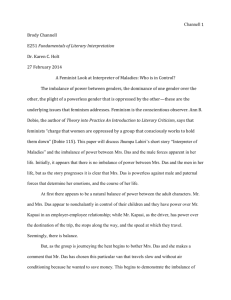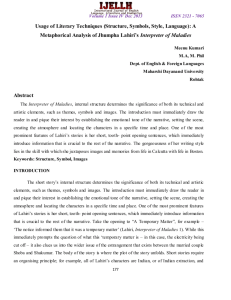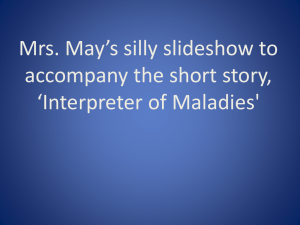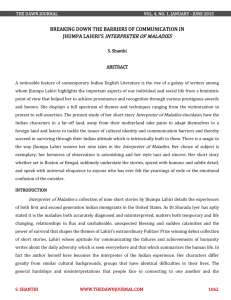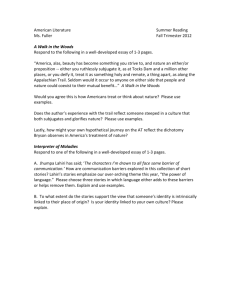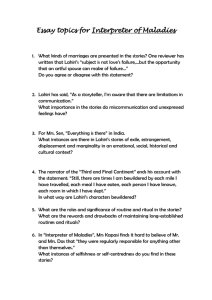Katelyn Przybyszewski
advertisement
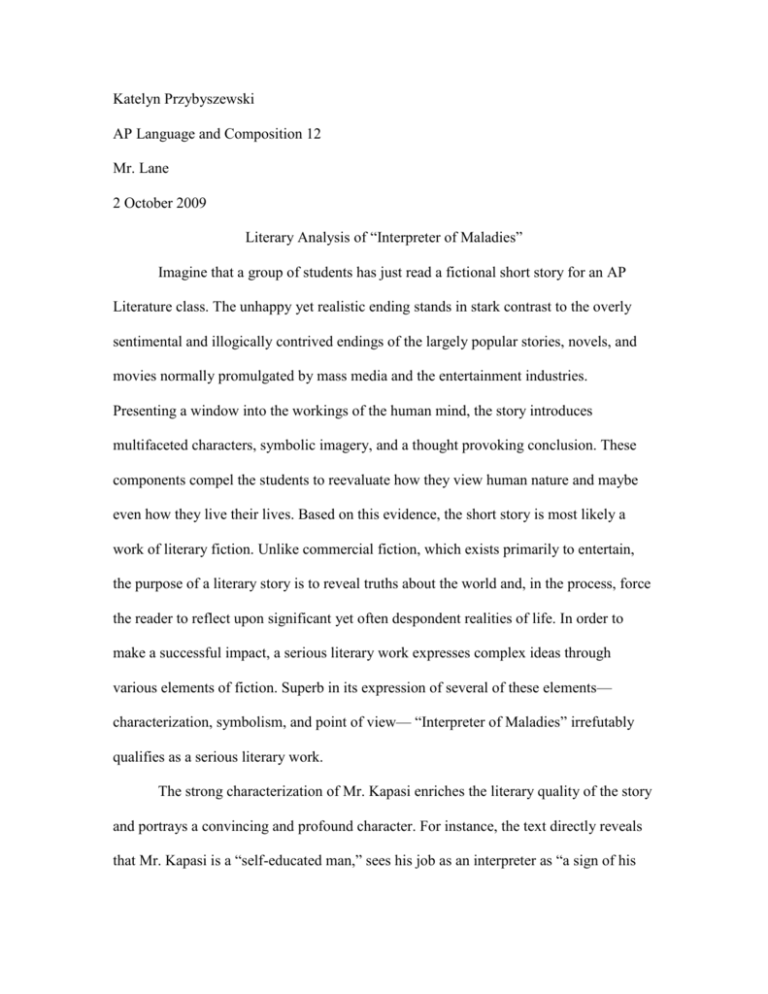
Katelyn Przybyszewski AP Language and Composition 12 Mr. Lane 2 October 2009 Literary Analysis of “Interpreter of Maladies” Imagine that a group of students has just read a fictional short story for an AP Literature class. The unhappy yet realistic ending stands in stark contrast to the overly sentimental and illogically contrived endings of the largely popular stories, novels, and movies normally promulgated by mass media and the entertainment industries. Presenting a window into the workings of the human mind, the story introduces multifaceted characters, symbolic imagery, and a thought provoking conclusion. These components compel the students to reevaluate how they view human nature and maybe even how they live their lives. Based on this evidence, the short story is most likely a work of literary fiction. Unlike commercial fiction, which exists primarily to entertain, the purpose of a literary story is to reveal truths about the world and, in the process, force the reader to reflect upon significant yet often despondent realities of life. In order to make a successful impact, a serious literary work expresses complex ideas through various elements of fiction. Superb in its expression of several of these elements— characterization, symbolism, and point of view— “Interpreter of Maladies” irrefutably qualifies as a serious literary work. The strong characterization of Mr. Kapasi enriches the literary quality of the story and portrays a convincing and profound character. For instance, the text directly reveals that Mr. Kapasi is a “self-educated man,” sees his job as an interpreter as “a sign of his Przybyszewski 2 failings,” and desires to “resolv[e] conflicts between people and nations” (Lahiri 147). Clearly, Mr. Kapasi is intelligent yet unfulfilled with his professional life; the latter quote suggests that apart from being infatuated with Mrs. Das, the reason Mr. Kapasi wants to write back and forth with her is so he can achieve his dream to interpret between two nations— India and the United States. In addition, Mr. Kapasi checks to make sure the rear car doors are locked, so to protect the young occupants of the vehicle, before commencing the daytrip (Lahiri 144). Although minor, this detail provides support that Mr. Kapasi is a responsible and caring man—two qualities that add to his characterization. However, although Mr. Kapasi is an intelligent, responsible, and practical man who works two jobs to support himself and his family, Mr. Kapasi’s inner thoughts reveal a different side of him. For instance, the narration states, “[p]erhaps, when Mr. Das was busy taking a picture, he would take her hand” (Lahiri 153). This example illustrates Mr. Kapasi’s compulsive attraction to Mrs. Das, as he is longing for physical contact. Also, the fact that he thinks to wait until her husband is not looking is sneaky and unfaithful, considering both he and Mrs. Das are married. Thus, Mr. Kapasi’s character traits, some of which are contradictory, add depth and intricacy to his character; these intricacies parallel the complexities of people in reality. Character credibility is a necessary component of literary fiction, for if the characters are not believable, the text itself loses credibility. The “Interpreter of Maladies” contains numerous symbols— meaningful objects, situations, people, and actions that have a meaning other than literal. On page 143, Mr. Kapasi notices the strawberry shaped calico on Mrs. Das’s blouse (Lahiri). The Przybyszewski 3 strawberry, a delicious and highly desirable fruit, symbolizes her irresistible appeal to Mr. Kapasi. Moreover, at the Sun Temple, the “entwined naked bodies, making love in various positions” (Lahiri 151) represent the possible future intimacy between Mr. Kapasi and Mrs. Das. Yet another example of symbolism in the story is the scrap of paper with Mr. Kapasi’s address on it which he gives to Mrs. Das, in hope of keeping in touch (Lahiri 150). When Mrs. Das first asks Mr. Kapasi for his address, he is thrilled at the thought of writing to her and possibly forming a close relationship with her, but, after Mrs. Das confesses her secret, Mr. Kapasi sees her as a selfish, pusillanimous, lazy, and altogether undesirable woman. Likewise, Mr. Kapsi realizes that Mrs. Das is ultimately unattainable due to her extensive problems and lack of will to resolve them. He does not wish to be involved in these problems in addition to his own issues with his wife. Thus, at the end of the story, the paper flying out of Mrs. Das’s purse symbolizes two ideas— the end of her potential relationship with Mr. Kapasi and also the end of his infatuation with her. Furthermore, the monkeys are a particularly important symbol. They serve to symbolize Mrs. Das’s secret—that Bobby is not Mr. Das’s son (Lahiri156). Bobby is the first person in the family to spot the monkeys (Lahiri 144), and, at the end of the novel, it is no coincidence that Bobby is the one surrounded and attacked by an aggressive hoard of monkeys, ripping his shirt and slashing his legs with their nails while Bobby stands powerless and frozen with fear (Lahiri 158). This situation is symbolic of the secret affair’s destructive impact on the relationship of the family and the emotional harm it will inevitably impose on Bobby in particular. One could only imagine the sense of betrayal and anger Bobby will feel when he finds out that he has been lied to his entire life, and Przybyszewski 4 the father figure he has known is not his biological father. Also, Bobby’s fear and helplessness can be interpreted figuratively because only Mrs. Das has the power to solve the issue by confessing her secret to her husband. Likewise, the fact that Mrs. Das asks Mr. Kapasi to save her son (Lahiri 158) indicates that she has neither the desire nor the courage to face and resolve her guilt. Serving to compress complex ideas, the story’s meaningful usage of symbolism identifies “Interpreter of Maladies” as a literary work of fiction. Lastly, the point of view greatly contributes to the story’s literary significance. The narration expresses Mr. Kapasi’s thoughts as he intently observes Mrs. Das “emerg[ing] slowly from his bulky white Ambassador, dragging her shaved, largely bare legs across the back seat” (Lahiri 141). These superfluous details highlight Mr. Kapasi’s obsession with Mrs. Das and indicate his sexual interest in her. Also, the quote shows that the point of view is third-person limited because the text is told through Mr. Kapasi’s perspective and only reveals his thoughts, while the thoughts of the other characters are unknown. Moreover, the text states, “he knew at that moment that he was not even important enough to be properly insulted” (Lahiri 157). This citation reveals Mr. Kapasi’s perception of Mrs. Das’s reaction to his interpretation; she is highly dissatisfied with his advice. She summarily dismisses Mr. Kapasi without the dignity of words by silently exiting the car (Lahiri 157). Through this action, Mrs. Das treats him as though he and his opinion are inconsequential. In addition, these quotes portray Mr. Kapasi’s thoughts concerning the situation that may not otherwise be revealed if the story was told from the perspective of a different character. Therefore, the third-person limited point of view Przybyszewski 5 presented in “Interpreter of Maladies” reveals the thoughts of Mr. Kapasi, critical underpinnings to understanding the literary value of the story. Through well-developed characterization, meaningful symbolism, and point of view, “Interpreter of Maladies” functions as a successful literary work. The characterization creates Mr. Kapasi with many layers and human complexities which emerges him as an incredibly realistic character; this believability adds to the story’s overall influence. A literary work also utilizes a variety of symbols and little details, far from being coincidental or insignificant, that function to add meaning to the story as a whole. The richness of symbolism found in this story, such as the monkeys and the strawberry appliqué, makes one want to read it multiple times simply to pick up on all the fine points and nuances of meanings. Lastly, the third-person limited point of view treats one to a daytrip into the life experience of Mr. Kapasi. Through his eyes, one experiences Mr. Kapasi’s perceptions of the American family he is helping to guide, along with his climactic ride of human emotions as he is aroused from a middle aged mundane existence to increasing enthrallment with young Mrs. Das, only to experience disenchantment and a crash back to reality. In conclusion, “Interpreter of Maladies” is most definitely a serious literary work; the elements of characterization, symbolism, and point of view each add tremendous depth and interest to the story. Przybyszewski 6 Works Cited Lahiri, Jhumpa. “Interpreter of Maladies.” Perrine's Literature: Structure, Sound, and Sense. Ed. Thomas R. Arp and Greg Johnson. 9th ed. Boston: Thomson, 2006. 141-159.


